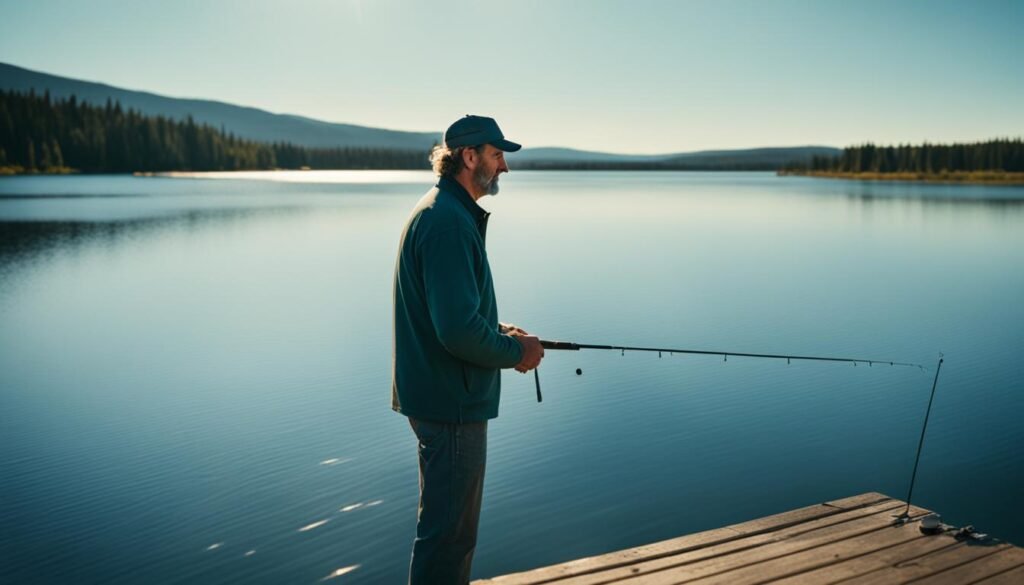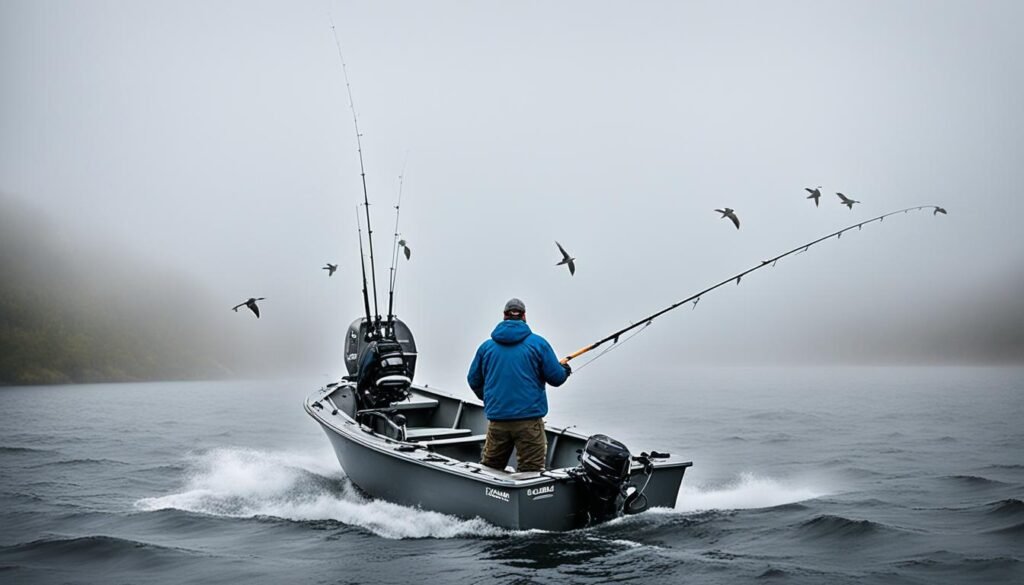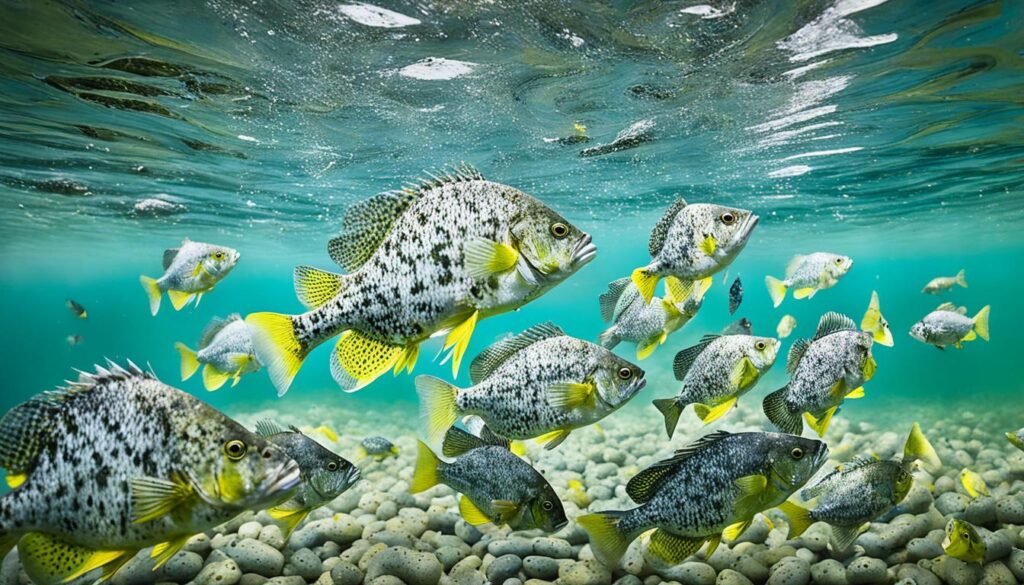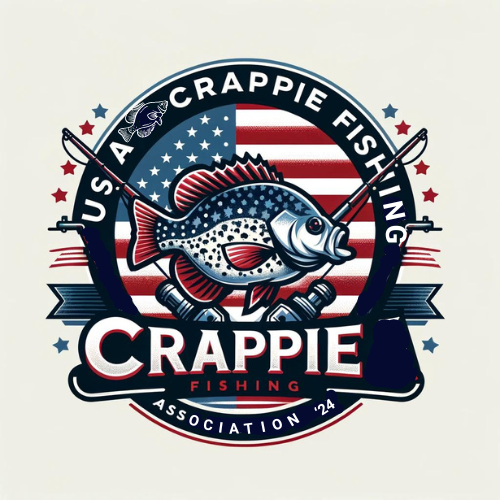“Fishing is much more than fish. It is the great occasion when we may return to the fine simplicity of our forefathers.” – Herbert Hoover
Are you seeking the best crappie fishing techniques? Want to learn how to catch crappie like a pro? Look no further! In this article, we will unveil the secrets of successful crappie angling, shared by fishing experts who have honed their skills over years of experience.
Key Takeaways:
- Understand crappie behavior and adjust your fishing strategies accordingly
- Locate crappie in shallow water during spring and find their preferred spawning grounds
- Use artificial bait effectively to attract crappie
- Explore unconventional crappie fishing spots
- Adapt to changing weather conditions and adjust fishing techniques
Finding Crappie in Early Spring: Key Behaviors to Consider
During the early spring season, crappie exhibit specific behaviors that anglers can leverage to improve their fishing success. As the water temperature rises to around 50 degrees Fahrenheit, crappie become more active and migrate out of deep water and into shallower areas. Understanding their movement patterns and preferred spawning grounds is crucial when targeting these prized fish.
One of the key factors to consider in early spring crappie fishing is the water temperature. When the temperature reaches around 50 degrees Fahrenheit, crappie start moving towards shallower waters. This change in temperature triggers their spawning instincts, making them more aggressive and actively feeding.
Shallow-water structures, such as brush piles and stake beds, become hotspots for crappie during this time. These structures provide cover and attract both spawning crappie and their prey. When fishing in early spring, focusing on these shallow-water structures increases your chances of catching crappie.
When targeting crappie in early spring, it’s essential to adapt your fishing techniques to the behavior of these fish. Using jigs or live bait near shallow-water structures can entice strikes from crappie. Slowly jigging your bait near or within brush piles and stake beds can mimic the movements of small prey, attracting crappie and triggering their predatory instinct.
As the crappie transition from deeper to shallower water, their feeding patterns change. They become more active and will often venture into shallower areas, even those with less cover. This shift in behavior provides excellent opportunities for anglers to catch crappie in early spring.
During the early spring, crappie move out of deep water and can be found near shallow-water structures like brush piles and stake beds.
Preferred Spawning Areas
In addition to considering their behavior in relation to water temperature, understanding the preferred spawning areas of crappie is essential for successful early spring fishing. Crappie typically spawn in areas with suitable substrate, such as gravel or sandy bottoms, near submerged vegetation or woody cover.
When searching for these spawning grounds, look for areas with gentle slopes and an abundance of submerged vegetation. Crappie prefer areas with cover, as it provides protection for their eggs and later for their young. These areas can include cattails, bulrushes, and submerged brush or fallen trees.
By focusing on these preferred spawning areas, anglers can increase their chances of encountering crappie during early spring. Fishing around these structures using appropriate bait or lures can yield great results.
Visual Cues and Water Clarity
In early spring, the water may still be relatively clear, allowing anglers to visually locate crappie and adapt their fishing strategies accordingly. Look for signs of crappie activity, such as schools of fish near the surface or disturbances caused by feeding fish. These visual cues can guide your fishing efforts and help you identify areas where crappie are actively feeding.
However, in some cases, early spring rains or runoff can result in murky or stained water, reducing visibility. In such conditions, rely on your depthfinder or fish finder to identify underwater structures and locate crappie. These tools can provide valuable insights into the presence of crappie and help you adjust your fishing techniques accordingly.
By understanding the key behaviors and preferred spawning areas of crappie in early spring, anglers can significantly increase their chances of success. However, it’s important to note that every body of water may have unique characteristics that affect crappie behavior. By observing and experimenting, you can fine-tune your strategies and enjoy a rewarding crappie fishing experience.
Summer Strategies: Catching Elusive Crappie in Deep Water
In the summer months, crappie tend to move back out into deeper water, making them more elusive and harder to catch. However, with the right strategies, you can still have a successful summer crappie fishing trip. Here are some tips to help you catch crappie in deep water:
- Night Fishing: One effective method for catching crappie in deep water during the summer is to fish at night under lights. The lights attract baitfish, which in turn attract crappie. Setting up near submerged structure or drop-offs can increase your chances of success.
- Fishing Near Grassy Areas: Another effective strategy is to fish near the edges of grassy areas where deeper water is nearby. Crappie often use these grassy areas for cover and foraging. By casting around the edges using small jigs and spinnerbaits, you can target crappie that are hiding in the vegetation.
- Target Brush Piles: Brush piles provide excellent hiding spots for crappie in deep water. By using your depthfinder to locate these structures, you can target specific areas where crappie are likely to be hiding. Small jigs and spinnerbaits are effective lures for enticing crappie to bite.
Remember to adjust your fishing depth depending on the time of day. During early morning and late evening, when crappie tend to be more active near the surface, fish closer to the top. As the sun gets higher in the sky, crappie may move deeper, so adjusting your lure depth accordingly can help increase your chances of a successful catch.
With these summer strategies, you’ll be well-equipped to catch elusive crappie in deep water and make the most of your summer crappie fishing adventures.
Tips from the Experts
“When targeting crappie in deep water during the summer, it’s important to stay patient and persistent. Experiment with different lure presentations and depths until you find what works best on that day. And don’t forget to bring a good quality depthfinder to help you locate structure and fish!” – Mark Johnson, Professional Crappie Angler
| Advantages | Disadvantages |
|---|---|
| Easier to find crappie | Crappie can be more elusive |
| Baitfish attraction | Deeper water requires specialized equipment |
| More opportunities for night fishing | Potential for limited visibility |
Crappie Fishing with Spoons: Unconventional but Effective
When it comes to crappie fishing, anglers are always seeking new techniques to improve their success rate. One unconventional yet highly effective method is using spoons. While spoons are commonly associated with trout fishing, some anglers have discovered their potential for catching crappie as well.
Crappie fishing with spoons can be particularly fruitful during the fall season. As the temperatures cool down, crappie tend to chase baitfish towards drop-offs and deeper areas. This behavior creates an opportunity for anglers to cast spoons near these locations and entice crappie with the spoon’s flash and movement.
“Using smaller trout spoons can attract crappie during the fall season,” says John Anderson, an experienced angler. “The key is to mimic the baitfish and cover the baitfish spectrum with neon blue and gold-colored spoons.”
Using spoons for crappie requires a different approach compared to traditional methods. Vertical jigging with spoons can be particularly effective in deep water during the fall season. By varying the speed and depth of the jigging motion, anglers can find the sweet spot that triggers crappie to strike.
To give you a visual example, here’s a table showcasing popular spoon types and their effectiveness for crappie fishing:
| Spoon Type | Effectiveness |
|---|---|
| Trout Spoons | Highly effective during fall |
| Neon Blue Spoons | Attracts crappie in clear water |
| Gold-Colored Spoons | Mimics baitfish and covers the spectrum |
By incorporating spoons into your crappie fishing arsenal, you can tap into a unique and effective technique that has proven successful for many anglers. Whether casting spoons near drop-offs or vertical jigging in deep water, experimenting with these unconventional methods can increase your chances of landing more crappie during the fall season.
Fall Crappie Fishing Tips:
- Use smaller trout spoons for increased flash and movement
- Mimic baitfish with neon blue and gold-colored spoons
- Target drop-offs and deeper areas where crappie chase baitfish
- Experiment with vertical jigging for deep water crappie

Thinking Outside the Box: Finding Crappie in Unexpected Locations
When targeting crappie, it is important to think outside the box and consider unconventional locations where crappie may be hiding. Anglers can explore spots with shallow flats and nearby deeper water, as crappie may move between these areas depending on weather conditions. Some anglers have found success in areas with mud, gravel, scattered hard bottoms, and old pencil reeds. However, it is crucial to adapt to changing conditions and use tools like underwater cameras to locate the right bottom composition for crappie.
Unique crappie fishing tactics can increase your chances of a successful catch. Exploring unconventional fishing spots is one such tactic. While crappie can often be found near structures like brush piles and stake beds, they may also be hiding in unexpected areas. Shallow flats with nearby deeper water can often hold crappie, as they move between these areas depending on weather conditions. Other unconventional spots to consider include areas with mud, gravel, scattered hard bottoms, and old pencil reeds.
Remember, crappie behavior can change with the seasons and weather conditions, so it’s important to adapt your fishing tactics accordingly. Using tools like underwater cameras can help you locate the right bottom composition for crappie, giving you an edge when exploring unconventional fishing spots.
Adapting to changing conditions is another key aspect of successful crappie fishing. It’s important to stay flexible and adjust your fishing techniques based on the current conditions. What works one day may not work the next, so be willing to try different tactics and experiment with your approach.
Exploring unconventional crappie fishing spots and employing unique tactics can greatly increase your chances of landing a successful catch. Whether it’s targeting shallow flats, investigating areas with mud and gravel bottoms, or utilizing underwater cameras to locate the right fishing spots, thinking outside the box can lead to exciting new fishing opportunities.
| Unconventional Crappie Fishing Spots | Unique Crappie Fishing Tactics | Adapting to Changing Conditions |
|---|---|---|
| Shallow flats | Exploring new lures and bait | Adjusting techniques based on weather |
| Areas with mud and gravel bottoms | Vertical jigging | Adapting to water temperature changes |
| Scattered hard bottoms | Casting near structure | Modifying fishing depth |
| Old pencil reeds | Using underwater cameras | Changing bait color and size |
Using Modern Equipment to Your Advantage
The use of modern equipment can greatly enhance your crappie fishing experience. By utilizing cutting-edge tools and technologies, you can increase your efficiency and improve your chances of a successful catch.
Trolling Motors with i-Pilot Technology
Trolling motors equipped with i-Pilot technology offer advanced features that allow you to navigate the waters with ease and precision. The i-Pilot system enables you to create and follow GPS-based routes, automatically control your boat’s speed and steering, and anchor in specific spots. This technology allows for systematic exploration of potential fish-holding areas, ensuring you cover more water and increase your chances of encountering crappie.
Underwater Cameras for Precise Targeting
Underwater cameras are invaluable tools that provide real-time visuals of what’s happening beneath the surface. By eliminating unproductive water and locating areas loaded with crappie food, these cameras save you valuable time and effort. You can use the footage to identify the specific structures crappie are holding near, such as brush piles or stake beds. This insight allows you to target those areas more effectively.

Ultralight Rods and Reels for Sensitivity
Ultralight rods and reels paired with the appropriate lines provide the necessary sensitivity for detecting the subtle bites of crappie. These lightweight fishing setups enable you to feel even the slightest nibble, allowing you to respond quickly and set the hook properly. With improved sensitivity, you can optimize your fishing technique and increase your crappie catch rate.
| Trolling Motors with i-Pilot Technology | Underwater Cameras | Ultralight Rods and Reels |
|---|---|---|
| Enables systematic exploration of potential fish-holding areas | Eliminates unproductive water and locates crappie-rich areas | Provides the necessary sensitivity to detect subtle bites |
| Allows for precise boat control and anchoring | Identifies specific structures crappie are holding near | Improves fishing technique and increases catch rate |
| Increases efficiency and coverage of fishing areas | Saves time and effort by eliminating unproductive spots | Enhances the angler’s ability to feel and respond to bites |
Adapting to Weather Changes: Finding Crappie in Different Depths
When it comes to crappie fishing, being prepared for weather changes is essential. As cold fronts move in, wind increases, or the barometer suddenly drops, crappie behavior can shift, causing them to seek refuge in deeper water. To successfully target crappie during these weather changes, anglers need to adjust their fishing strategies and explore deeper depths.
One effective technique is to cast jig-and-minnow setups and allow them to sink before starting a slow swimming retrieve. This gives crappie in deeper waters ample time to notice the bait and strike. To maximize sensitivity and increase the chances of detecting subtle bites, anglers should use rods with soft actions and pair them with sensitive reels.
Small adjustments can make a big difference when targeting crappie in different depths. One such adjustment is modifying the color of the fishing line. As light penetration decreases with depth, using a darker line can make it less visible to crappie and increase the chances of them taking the bait. Additionally, using depthfinders to accurately locate crappie in deeper water can significantly improve success rates.
Being adaptable is the key to successful crappie fishing. When weather conditions change, don’t hesitate to adjust your strategies and explore deeper water. These adjustments, combined with the right equipment and techniques, can lead to rewarding catches even during challenging weather.

Tips for Adjusting Fishing Strategies during Weather Changes:
- Cast jig-and-minnow setups and allow them to sink before retrieving.
- Use rods with soft actions and sensitive reels to detect subtle bites.
- Consider using a darker fishing line to make it less visible in deeper water.
- Utilize depthfinders to accurately locate crappie in deeper depths.
Key Takeaways:
Adapting to weather changes is crucial for successful crappie fishing. When conditions shift, crappie often move into deeper water, requiring anglers to adjust their fishing strategies accordingly. By casting jig-and-minnow setups, using sensitive rods and reels, adjusting line color, and using depthfinders, anglers can target crappie in different depths and increase their chances of a successful catch.
Stay prepared and adaptable, and you’ll be ready to take on whatever weather changes come your way while fishing for crappie.
Targeting Food Sources: Locating Crappie by Finding Groceries
When it comes to catching crappie, understanding their feeding habits and finding their preferred food sources can significantly improve your chances of success. After ice-out and before the spawn, crappie are on the lookout for nourishment to replenish their energy. By locating areas with abundant food sources, you can increase your chances of finding active crappie hotspots.
To identify potential crappie hotspots, using depthfinders can be a game-changer. These devices allow you to scan the water column and identify minute organisms that represent crappie food. By studying the patterns and distribution of these organisms, you can predict the presence of crappie nearby.
Once you have located an area with potential crappie food sources, it’s time to strategically position your bait. Placing your bait slightly above schools of baitfish can entice crappie to strike. Slow and soft presentations are often effective, mimicking the natural movement of their prey and enticing crappie to bite.
Understanding Crappie Food Sources
Crappie are opportunistic feeders and target a variety of food sources depending on the season and availability. Some common crappie baitfish include shad, minnows, and small panfish such as bluegill. To enhance your success, it’s essential to understand the specific food sources crappie are targeting in your fishing location.
“To consistently catch crappie, you need to think like a crappie. Locate their food sources, and you’ll find the crappie.”
By observing the behavior of other aquatic species in the area and the presence of certain vegetation, you can gain valuable insights into crappie food sources. For example, if you notice schools of shad or clusters of submerged vegetation, it’s likely that crappie are feeding on these resources.
Developing a keen eye for identifying potential crappie food sources and adapting your fishing approach accordingly can greatly enhance your success on the water. Keep in mind that crappie behavior can vary depending on the region and the time of year, so it’s important to stay observant and adjust your tactics as needed.

Fishing Techniques: Tips for a Successful Crappie Catch
Mastering effective fishing techniques is crucial for a successful crappie catch. Whether you’re a novice angler or an experienced fisherman, employing the right techniques can significantly improve your chances of reeling in a crappie. In this section, we’ll explore some tried-and-true methods that have proven to be effective in crappie fishing.
Jigging for Crappie
Jigging is a popular and effective technique for targeting crappie in shallow water. Using small jigs in various colors and designs can mimic the movements of baitfish, enticing crappie to strike. When jigging, it’s essential to vary your retrieval speed and depth to determine what triggers a bite. Experiment with different jig sizes and colors to find what works best in specific conditions.
“Jigging is an art form in crappie fishing. The key is to keep the jig at the appropriate depth and use subtle movements to mimic the natural swimming action of baitfish.”
When jigging for crappie, target likely spots such as pencil reeds, submerged trees, and brush piles. These areas provide cover and attract crappie seeking shelter and food. Cast your jig near these structures and retrieve it with short, jerking motions to imitate the movement of injured baitfish.
Casting for Crappie
Casting is another effective technique for catching crappie, especially when targeting isolated fish. When casting, use lightweight spinning or baitcasting gear and cast your bait into areas where crappie are likely to hide, such as around fallen trees or docks. It’s important to be stealthy and avoid spooking the fish. Use light line and make accurate, quiet casts to increase your chances of success.
Once your bait is in the water, retrieve it with a steady and controlled motion. Crappie are known to strike bait aggressively, so be ready for a quick and decisive hookset. Adjusting your retrieval speed and experimenting with different baits, such as soft plastics or small crankbaits, can help you find the presentation that entices crappie to bite.
Employing Modern Equipment
In recent years, technological advancements in fishing equipment have revolutionized the way anglers target crappie. Utilizing modern tools like trolling motors and anchoring systems can give you an edge when it comes to positioning yourself in areas with active crappie schools.
Equipping your boat with a trolling motor, especially one with features like spot-lock and GPS navigation, allows for precise and silent maneuvering. This is particularly useful when fishing an area with structure or cover where crappie tend to congregate. Anchoring systems, such as electronic anchors or shallow water anchors, can help you stay in one spot and continue fishing a productive area without drifting away.
In addition to motorized equipment, underwater cameras have become a game-changer in crappie fishing. These cameras allow anglers to see beneath the surface and observe the behavior and location of crappie schools, giving valuable insights into their movements and feeding patterns.
Summary
When it comes to crappie fishing techniques, employing small jigs and baitfish, casting accurately to likely spots, and using modern equipment can significantly improve your success rate. Remember to adjust your technique based on the mood of the crappie and experiment with different presentations to find what works best. By incorporating these fishing techniques into your repertoire, you’ll be well on your way to a successful crappie catch.
Experience and Adaptability: The Key to Successful Crappie Fishing
Successful crappie fishing requires a combination of experience and adaptability. Understanding the behavior of crappie in various seasons and weather conditions is crucial for adjusting your strategies and improving your chances of a fruitful fishing trip.
Thinking outside the box and exploring unconventional locations can often lead to exceptional results. By venturing beyond the usual spots, you may uncover hidden gems where crappie congregates. Be open to experimenting and adapting your techniques to different environments, as this flexibility can bring about surprising success.
“The more time you spend on the water, the more the fish reveal their secrets.” – Roland Martin
Using modern equipment can give you an edge in your crappie fishing endeavors. Take advantage of tools like underwater cameras that allow you to locate underwater structures where crappie might be hiding. Similarly, trolling motors equipped with the latest technology can help you navigate efficiently and explore potential fishing spots with ease.
When it comes to targeting crappie, understanding their preferred food sources can significantly increase your chances of a successful catch. By identifying the baitfish crappie prey upon, you can strategically position your bait and entice their appetite effectively.
Adjusting to changing conditions is paramount in crappie fishing. Weather fluctuations, such as cold fronts or sudden drops in barometric pressure, can influence crappie behavior and push them into deeper water. Adapting your fishing techniques to these conditions, such as casting jig-and-minnow setups and fishing deeper waters, can lead to notable results.
Ultimately, crappie fishing is an art that requires time, patience, and a willingness to learn from every fishing expedition. The more experience you gain, the better you will become at understanding crappie behavior, adapting to conditions, and honing your fishing techniques.
Conclusion
After delving into the world of crappie fishing, it is clear that expert crappie fishing advice, effective crappie fishing tactics, and top crappie fishing secrets can significantly improve your chances of a successful fishing experience. By understanding the behavior of crappie, anglers can tailor their strategies to match the preferences of these elusive fish.
Adapting to changing conditions is crucial in crappie fishing. Whether it’s adjusting your fishing techniques during different seasons or adapting to weather changes, flexibility is key. Additionally, utilizing modern equipment such as trolling motors and underwater cameras can provide a competitive edge in locating and catching crappie.
Targeting specific locations where crappie are likely to be found, considering food sources, and adapting your techniques based on the mood of the fish can greatly increase your success rate. However, the ultimate key to mastering crappie fishing lies in experience and a willingness to experiment. The more time spent on the water, the more you will learn about these fascinating fish and the more likely you are to enjoy a rewarding catch.
